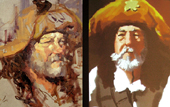Much as I love most things digital, I occassionally come across an example of how lacking the virtual still is in comparison to the material. A recent staged showdown between a traditional oil painter and a digital “painter” makes this all too clear. Somehow the digital “painting” just doesn’t have the same vitality as the old-fashioned brush and paint version. Compare, which do you think is better?

I think there is some equivalent for books, but only for really fine books with delicious velvety (or thick toothy) paper, elegant typography, masterful craftsmanship. In short, the book as art object has the kind of appeal that probably will not be userped by its digital counterpart. However, there is a certain excitement to live, electric, dynamic, cinematic, interactive digital media that traditional forms can’t compete with. Maybe the mistake of this “showdown” was to ask digital art to try to be traditional oil painting and what’s the point of that?
One more thing, I will never give up my gorgeous Lynd Ward books, but if a digital version came along full of annotations, images of Ward at work, video or audio clips, biographical information, links to other fans of Ward, etc… I would buy it in a heartbeat.
if:book
A Project of the Institute for the Future of the Book

I’m not sure this is really the right comparison. Digital art is a different genre than painting, so it’s a little unfair to compare a traditional painting to a digital work that tries to imitate its style. It’s more difficult when you compare with a work designed completely for the digital environment. Take this screenshot from Tron 2.0.
It’s a striking bit of “art” taken from a video game. Now whether you prefer the hand-painted work or the digital one becomes a matter of personal preference. I’d also submit that a traditional painter would have a difficult time “imitating” the Tron screenshot.
I have so many thoughts on this topic, but will try to limit them to a blog-sized comment.
Comparing traditional modes of image making, like oil painting, woodcut, etching, or drawing with new digital modes is a fair comparison. When oil painting came along, people debated whether it was better than egg tempra or fresco. I think it can be productive to examine the advantages and disadvantages of digital image making by putting it alongside traditional methods such as oil painting.
In the Introduction to his book “The Language of New Media,” Lev Manovich writes about how he mastered classical drawing in order to pass the entrance exams for the Moscow Architectural Institute. The eight-hour exam required him to draw from a plaster cast of a classical sculpture. He was given the most difficult cast, “the head of Venera. It is more difficult because, in contrast to casts of male heads…it does not have well-defined facets; the surfaces join smoothly together as though constructed with a spline modeling program.” Fast forward ten years (1985) Manovich is working in New York for Digital Effects (the company that produced Tron). He is working with a 3-D rendering program and he notes it’s advantages and disadvantages. He says: “I wonder why I had to spend years learning to draw in perspective when a computer could do it in seconds.” He also says: “I want to produce a synthetic image of an antique bust, but the task turns out to be impossible. The software is able to create 3-D objects only out of primitive geometric forms such as cubes, cylinders, and spheres–so I am forced to settle for a composition made out of these primitive forms.” The software has become much more sophisticated since 1985, but there are still many limitations.
Clearly each of these mediums has strengths and weaknesses, and I am interested in talking about what makes digital images interesting, what unique capacities do they have for human expression? Also interested in what will happen if/when digital imagemaking (including digital photography and digital video) becomes dominant and begins to dictate aesthetic “norms.” I’m very interested in how digital art (in all its forms including literature) will change our aesthetic experience.
hi,
there are good and bad artists in every medium. i personally use painter in such a way that people are astonished when they discover that my work is digital. not only that, but the quality of the print may vary and paper also plays a role in the vitality of the print. i hate when people say some art form isn’t as good. would you say oil paint isn’t a true medium? photography? digital is just another medium, and in the right hands, is a fantastic creative tool.
see my blog at http://chavahudson.typepad.com.
best,
chava